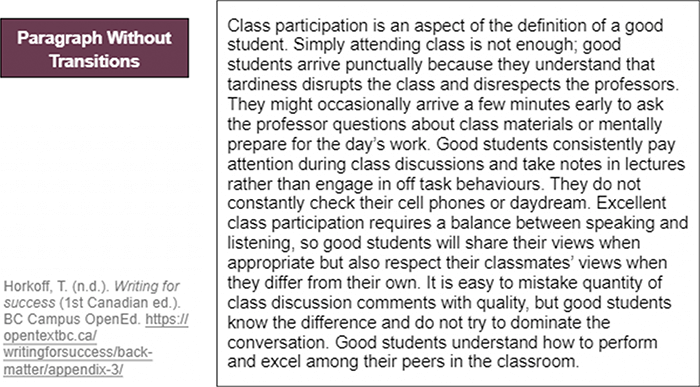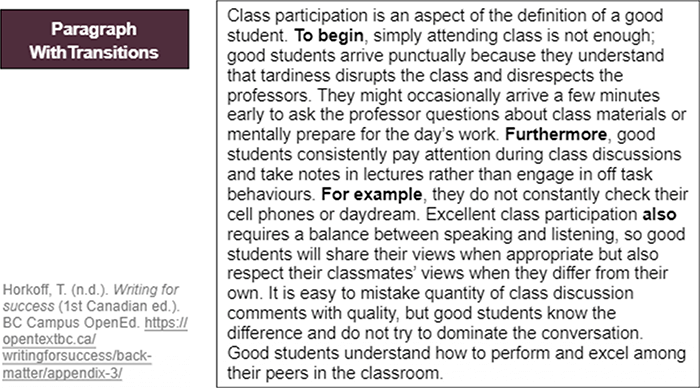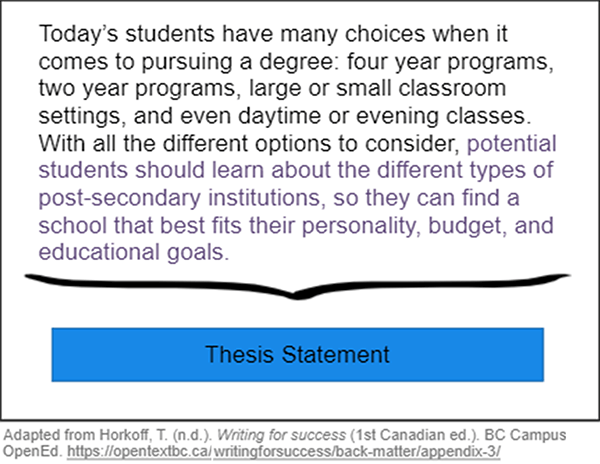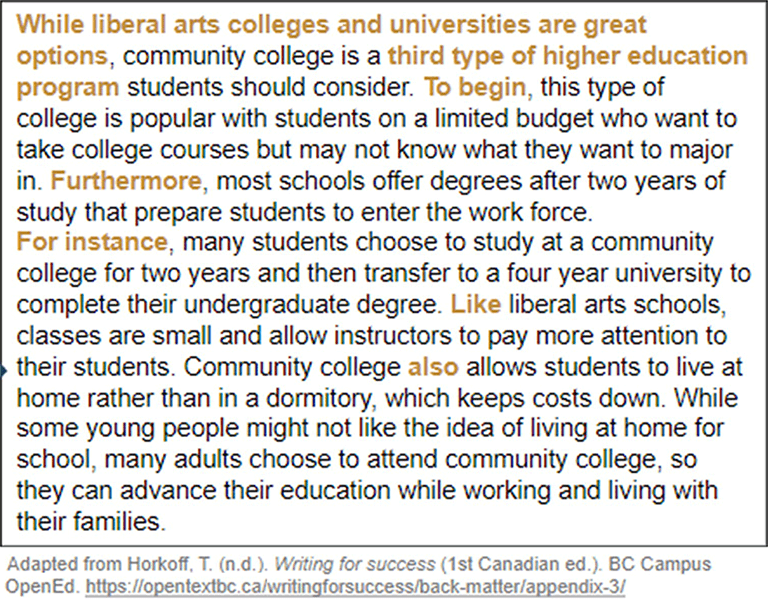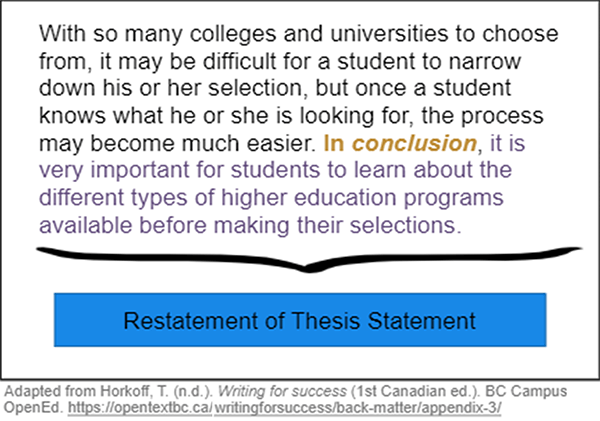3 APA Citations
Professors at Confederation College will require you to format your assignments according to APA conventions and use the APA method for any paper or presentation that contains information taken from a source.
Always use the Confederation College APA Manual as a guide to ensure your work is correct.
Learning Objectives
After completing this chapter, you will be able to
- cite your sources by including an in-text citation for paraphrases and quotes
- use narrative style citations
- use parenthetical style citations
The APA method of creating citations and references allows readers to easily find the source of information you’ve used in an assignment or report. When you cite your sources, you give credit to the original source of the information, and you strengthen your argument by showing that your ideas are supported by facts and opinions published by experts in the field.
In-text Citations
You must include in-text citations next to EVERY item of information from a source. A source can be any text, video, or podcast that you took information from.
An in-text citation tells the reader the author’s last name and the publication year. You also need to include a page number (or paragraph number if your document doesn’t have pages) or a time-stamp (if your information came from a video or podcast) to tell your reader exactly where in the source the information is from. You must put these citations next to EVERY item of information from a source.
If you don’t have an author, or if you don’t know the year of publication, don’t worry – you can still cite your source. Your APA manual explains these issues in detail.
General Guidelines for Tricky Sources
- If there’s no publication date, use the abbreviation for no date (n.d.)
- If there’s no author, use the name of the government agency or organization: (Statistics Canada, 2020, para. 1).
- If there is no author or organization, use an abbreviation of the article/website title in place of the author’s name: (“10 tips”, n.d., para. 2).
- If you have two authors, list both of their last names: (Smith & Jones, 2020, p. 4).
- If you have more than two authors, state the first author’s last name and the Latin phrase et al. : (Smith et al., 2021, p. 27)
- If there are no page numbers but the source has headings, give the name of the heading, followed by the word “section” and the number of the paragraph within the section it is from (Smith, 2012, Discussion section, para. 3)
If you use information from a source and you do not include a citation, you have committed an act of academic dishonesty called plagiarism. Please review Confederation College’s “Academic Integrity Policy” and the “Student Charter of Rights and Responsibilities”. Plagiarism is a serious offence.
Learning Check
Paraphrasing, Patchwriting, and Direct Quoting
When you include information from a source, you might paraphrase (put in your own words) or directly quote (using the exact words from the source) that information.
Most professors prefer students to paraphrase information. When you paraphrase information, you put that information into your own words. By restating the information, you demonstrate to your professor that you have a strong understanding of the content of the original.
To learn more about paraphrasing, review the Paraphrasing and Paraphrasing vs. Patchwriting chapters of this e-text.
If you directly quote some information from a source, you need to put the author’s words in “quotation marks.” These “quotation marks” show that you have borrowed the author’s words as well as their ideas or information. If you’ve put the information into your own words, then you do not use “quotation marks”, but you still need to include a citation to show where the information is from. To learn more about direct quoting, review the Direct Quoting chapter of this e-text.
Learning Check
Signal phrases: Narrative and Parenthetical Style Citations
There are two ways to include your in-text citation:
- parenthetical style
- narrative style
| Direct Quote | Paraphrase | |
| Parenthetical | According to one government report on Canadian immigrants, “20% experienced over-qualification at least once in 2006 or in 2016” (Statistics Canada, 2020, para. 2). | One government report claimed that approximately one fifth of immigrants to Canada are over-qualified for the jobs they obtain in this country (Statistics Canada, 2020, para. 2). |
| Narrative | Statistics Canada (2020) reported that “20% experienced over-qualification at least once in 2006 or in 2016” (para. 2). | Statistics Canada (2020) stated that approximately one fifth of immigrants to Canada are over-qualified for the jobs they obtain in this country (para. 2). |
In the parenthetical style, all three pieces of citation information (author, date, location) are placed in parentheses at the end of the sentence, just before the final period.
In the narrative style, the three pieces of information are still present, but they are not placed together. The author (or the organization functioning as the author) is part of the sentence, so it is not in parentheses. The date always must be placed next to the author, and the location (page or paragraph number) must be placed at the end of the sentence, just before the final period.
Notice that APA style generally requires the use of past tense verbs to introduce quotes or paraphrases. Check out this list of appropriate words that you can use.
Transitional Words and Phrases
Transitional words and phrases enable your reader to understand how one idea relates to the previous idea. Transitions form logical connections between ideas, and they strengthen the organization of these ideas. Transitions signal the order of ideas, highlight relationships, unify concepts, and let readers know what’s coming next or remind them about what’s already been covered.
When instructors or peers comment that your writing is choppy, abrupt, or needs to “flow better”, those are some signals that you might need to work on building some better transitions into your writing.
Compare the sample paragraphs with and without transitions; notice how the paragraph with the transitions flows better.
Meaning and Usage of Common Transitions
Effectively incorporating transitions often depends upon your ability to identify words or phrases that will indicate for the reader the kind of logical relationships or connections you want to convey.
View the chart below or check out this website to see how to use different transitions and conjunctions.
Grammar Tip
When your teachers talk about "transitional elements," they are probably referring specifically to "conjunctive adverbs": therefore, however, additionally, finally, etc. These types of transitional elements link ideas, but they do not join sentences.
Typically, these transitions can only be placed
1. At the beginning of a sentence:
I studied hard. Consequently, I passed the test.
2. After a semi-colon that joins two related sentences
I studied hard; consequently, I passed the test.
Remember that a comma is needed after the transitional element to offset it from the main sentence clause.
Transitions to Show Order of Importance
Transitions can be used to show order of importance, which means arranging your ideas from most to least important or vice versa. Sometimes you may want to end with the most important idea so that it acts as the climax at the end of the paragraph or essay.

Transitions to Show Additional Support
Transitions can be used to show additional support for an idea.

Transitions to Introduce Examples
The simplest way to tell a reader that an example will follow is to say so using a transitional word or phrase.

Transitions to Show Time Order
Transitions can be used to indicate chronological order, which means to arrange ideas in order from present to past or from past to present. Similarly, transitions can be used to show a sequence of events, which means to arrange ideas in the order that they happen.

Transitions to Show Similarity
Transitions can be used to compare ideas. In other words, transitions can connect ideas by suggesting that they are in some ways alike.

Transitions to Show Contrast
Transitions can be used to contrast ideas. In other words, transitions can connect ideas by suggesting that they are in some way different.

Transitions to Summarize or Conclude
Transitions are also used to introduce a summary or conclusion in a paragraph or essay.

Transitioning Between Paragraphs and Sections
It’s important to consider how to emphasize the relationships not just between sentences but also between paragraphs in your essay.
Use Signposts
Signposts are basic transitional words or phrases that indicate where you are in the process of organizing an idea. For example, signposts might indicate that you are introducing a new concept, that you are summarizing an idea, or that you are concluding your thoughts.
Be careful not to overuse these types of transitions in your writing. Instead, think of more creative ways to let your readers know where they are situated within the ideas presented in your paragraph or essay.
You might say, “The first problem with this practice is….”. Or you might say, “The next issue to consider is…..”. Or you might say, “Some final thoughts about this topic are….”.
Use Forward-Looking Sentences at the End of Paragraphs
Sometimes, as you conclude a paragraph, you might want to give your readers a hint about what’s coming next.
This transitional strategy can be tricky to employ. Make sure that the conclusion of your paragraph doesn’t sound like you’re leaving your readers hanging with the introduction of a completely new or unrelated topic.

Use Backward-Looking Sentences at the Beginning of Paragraphs
Rather than concluding a paragraph by looking forward, you might instead begin a paragraph by looking back.

Sample Essay Showing Placement and Type of Transitions
Introductory Paragraph
First Body Paragraph
Second Body Paragraph
Third Body Paragraph
Concluding Paragraph
Evaluate Your Use of Transitions
Remember to include enough transitions so the reader can easily follow the flow of your ideas, but do not overuse the same transitions to the point where they become redundant.
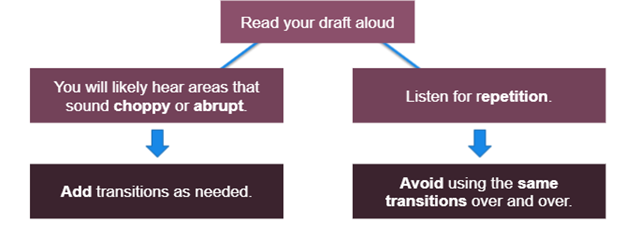
Learning Check
Drag the appropriate transition into its correct spot in the paragraphs.
Additional Resources
To learn more about transitional elements
- watch this video
- read about coherence in Chapter 8.4 of Writing for Success [1]
- review the list of transitions and their meanings at the UW-Madison Writing Centre
- try this interactive online activity on Connectives

